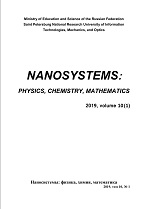|
CHEMISTRY AND MATERIAL SCIENCE
The role and effect of CO$_2$ flow rate on the structure formation of ultrahigh porous activated carbon from H$_3$PO$_4$-impregnated waste cotton used as supercapacitor electrode material
Nguyen K. Thachab, Ilya S. Krechetova, Valentin V. Berestova, Oleg I. Kana, Ivan A. Maslochenkoa, Tatyana L. Lepkovaa, Svetlana V. Stakhanovaac
a National University of Science and Technology "MISIS", Moscow, Russia
b College of electromechanical and civil engineering, Vietnam National University of Forestry, Hanoi, Vietnam
c Mendeleev University of Chemical Technology of Russia, Moscow, Russia
Abstract:
Ultrahigh porosity activated carbon (AC) was made from H$_3$PO$_4$-impregnated waste cotton precursor by carbonization in Ar and physical activation in variable CO$_2$ flow rate with ultrahigh heating rate. The presence of CO$_2$ in the activation plays an important role in the formation of the porous structure of AC. The obtained AC had outstanding physical and electrochemical properties. The specific surface area and micropore volume of AC reached 4800.7 m$^2$/g and 2.499 cm$^3$/g, respectively. The pore size distribution was mainly in the microporous region. The electrochemical double-layer capacitors (EDLCs) with AC-based active electrode and an electrolyte solution of 1 M 1,1-dimethylpyrrolidinium tetrafluoroborate in acetonitrile were fabricated. The specific capacitance of electrode material degraded less than 10% with the highest value of 105.7 F/g at 0.05 A/g as the specific current varied from 0.05 A/g – 15 A/g. After 8000 charge-discharge cycles at 1 A/g, the specific capacitance of the AC-base electrode material fabricated at CO$_2$ flow rate greater than 200 ml/min degraded less than 15% with the highest value of 101.2 F/g. The optimal CO$_2$ flow rate for fabricating waste cotton-based AC is 200 ml/min.
Keywords:
activated carbon, porous activated carbon, cellulose, waste cotton, supercapacitor.
Received: 12.01.2023
Revised: 08.04.2023
Accepted: 25.06.2023
Citation:
Nguyen K. Thach, Ilya S. Krechetov, Valentin V. Berestov, Oleg I. Kan, Ivan A. Maslochenko, Tatyana L. Lepkova, Svetlana V. Stakhanova, “The role and effect of CO$_2$ flow rate on the structure formation of ultrahigh porous activated carbon from H$_3$PO$_4$-impregnated waste cotton used as supercapacitor electrode material”, Nanosystems: Physics, Chemistry, Mathematics, 14:4 (2023), 489–497
Linking options:
https://www.mathnet.ru/eng/nano1214 https://www.mathnet.ru/eng/nano/v14/i4/p489
|

| Statistics & downloads: |
| Abstract page: | 56 | | Full-text PDF : | 20 |
|




 Contact us:
Contact us: Terms of Use
Terms of Use
 Registration to the website
Registration to the website Logotypes
Logotypes







 Citation in format
Citation in format 